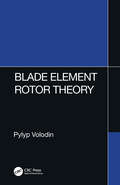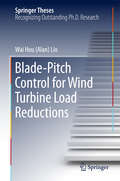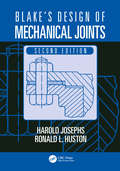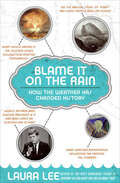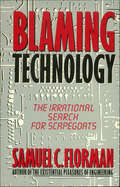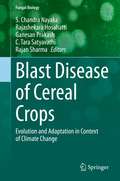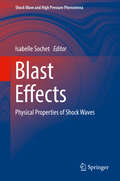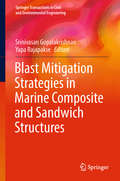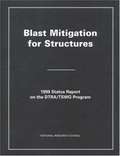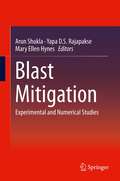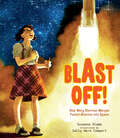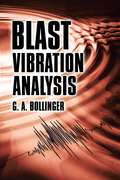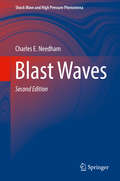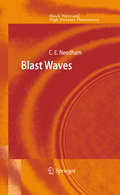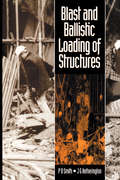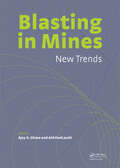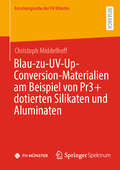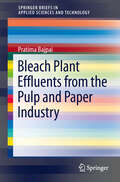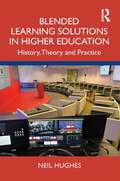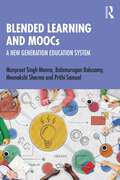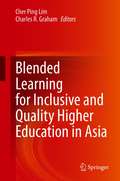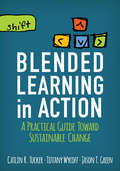- Table View
- List View
Blackout: With an Afterword on the Blackout of 2003
by James E. GoodmanOn July 13, 1977, there was a blackout in New York City. With the dark came excitement, adventure, and fright in subway tunnels, office towers, busy intersections, bus terminals, high-rise stairwells, hotel lobbies, elevators, and hospitals. There was revelry in bars and restaurants, music and dancing in the streets. On block after block, men and women proved themselves heroes by helping neighbors and strangers make it through the night. Unfortunately, there was also widespread looting, vandalism, and arson, and even before the police restored order, people began to ask and argue about why. Why did people do what they did when the lights went out?
Blade Element Rotor Theory
by Pylyp VolodinBlade Element Rotor Theory This book presents an extension of the conventional blade element rotor theory to describe the dynamic properties of helicopter rotors. The presented theory focuses on the accurate mathematical determination of the forces and moments by which a rotor affects its rotorcraft at specified flight conditions and control positions. Analyzing the impact of a blade's non-uniform properties, the book covers blade twisting, the non-rectangular planform shape of a blade, and inhomogeneous airfoil along the blade. It discusses inhomogeneous induced airflow around a rotor disc in terms of the blade element rotor theory. This book also considers the impact of flapping hinge offset on the rotor's dynamic properties. Features • Focuses on a comprehensive description and accurate determination of the rotor's aerodynamic properties • Presents precise helicopter rotor properties with inhomogeneous aerodynamic properties of rotor blades • Considers inhomogeneous distribution of induced flow • Discusses a mathematical model of a main helicopter rotor for a helicopter flight simulator This book is intended for graduate students and researchers studying rotor dynamics and helicopter flight dynamics
Blade-Pitch Control for Wind Turbine Load Reductions
by Wai Hou LioThis thesis investigates the use of blade-pitch control and real-time wind measurements to reduce the structural loads on the rotors and blades of wind turbines. The first part of the thesis studies the main similarities between the various classes of current blade-pitch control strategies, which have to date remained overlooked by mainstream literature. It also investigates the feasibility of an estimator design that extracts the turbine tower motion signal from the blade load measurements. In turn, the second part of the thesis proposes a novel model predictive control layer in the control architecture that enables an existing controller to incorporate the upcoming wind information and constraint-handling features. This thesis provides essential clarifications of and systematic design guidelines for these topics, which can benefit the design of wind turbines and, it is hoped, inspire the development of more innovative mechanical load-reduction solutions in the field of wind energy.
Blake's Design of Mechanical Joints (Mechanical Engineering)
by Ronald L. Huston Harold JosephsBlake's Design of Mechanical Joints, Second Edition, is an updated revision of Alexander Blake’s authoritative book on mechanical joint and fastener design. This revision brings Blake’s 1985 volume up-to-date with modern developments in joint design, and recent technological advances in metallic and non-metallic materials, and in adhesive joining technologies. The book retains Blake’s lucid, readable style and his balance of basic concepts with practical applications. Coverage of statistical methods, computational software usage, extensive examples, and a full glossary have been added to make the new edition a comprehensive, practical sourcebook for today's mechanical design engineers.
Blame It on the Rain: How the Weather Has Changed History
by Laura LeeAn amazing, enlightening, and endlessly entertaining look at how weather has shaped our world.Throughout history, great leaders have fallen, the outcomes of mighty battles have been determined, and the tides of earth-shattering events have been turned by a powerful, inscrutable force of nature: the weather. In Blame It on the Rain, author Laura Lee explores the amazing and sometimes bizarre ways in which weather has influenced our history and helped to bring about sweeping cultural change. She also delights us with a plethora of fascinating weather-related facts (Did you know that more Britons die of sunburn every year than Australians?), while offering readers a hilarious overview of humankind's many absurd attempts to control the elements.If a weather-produced blight hadn't severely damaged French vineyards, there might never have been a California wine industry. . . .What weather phenomenon was responsible for the sound of the Stradivarius?If there had been a late autumn in Russia, Hitler could have won World War II. . . .Did weather play a part in Truman's victory over Dewey?Eye-opening, edifying, and totally unexpected, Blame It on the Rain is a fascinating appreciation of the destiny-altering vagaries of mother nature—and it's even more fun than watching the Weather Channel!
Blaming Technology: The Irrational Search for Scapegoats
by Samuel C. FlormanAn award-winning civil engineer and contractor explores the impact advanced technology has on the world and society.Blaming Technology: The Irrational Search for Scapegoats is Samuel C. Florman's 1981 discussion of the state of technology and engineering in the United States, including the pros and cons, and the public's perceptions and opinions. An optimist at heart, he believes that technological innovation improves lives and defends his profession and achievements from pessimists and critics who are convinced that modern advancements dehumanize people.
Blast Disease of Cereal Crops: Evolution and Adaptation in Context of Climate Change (Fungal Biology)
by Rajan Sharma S. Chandra Nayaka H. Rajashekara Ganesan Prakash C. Tara SatyavathiBlast is an important foliar disease that infects the majority of cereal crops like rice, finger millet, pearl millet, foxtail millet and wheat, and thus resulting in a huge economic impact. The pathogen is responsible for causing epidemics in many crops and commonly shifts to new hosts. Magnaporthe spp. is the most prominent cause of blast disease on a broad host range of grasses including rice as well as other species of poaceae family. To date, 137 members of Poaceae hosting this fungus have been described in Fungal Databases. This book provides information on all blast diseases of different cereal crops. The pathogen evolves quickly due to its high variability, and thus can quickly adapt to new cultivars and cause an epidemic in a given crop. Some of the topics covered here include historical perspectives, pathogen evolution, host range shift, cross-infectivity, and pathogen isolation, use of chemicals fungicides, genetics and genomics, and management of blast disease in different cereal crops with adoption of suitable methodologies.In the past two decades there have been significant developments in genomics and proteomics approaches and there has been substantial and rapid progress in the cloning and mapping of R genes for blast resistance, as well as in comparative genomics analysis for resolving delineation of Magnaporthe species that infect both cereals and grass species. Blast disease resistance follows a typical gene-for-gene hypothesis. Identification of new Avr genes and effector molecules from Magnaporthe spp. can be useful to understand the molecular mechanisms involved in the fast evolution of different strains of this fungal genus. Advances in these areas may help to reduce the occurrence of blast disease by the identification of potential R genes for effective deployment. Additionally, this book highlights the importance of blast disease that infects different cereal hosts in the context of climate change, and genomics approaches that may potentially help in understanding and applying new concepts and technologies that can make real impact in sustainable management of blast disease in different cereal crops.
Blast Effects: Physical Properties of Shock Waves (Shock Wave and High Pressure Phenomena)
by Isabelle SochetThis book compiles a variety of experimental data on blast waves. The book begins with an introductory chapter and proceeds to the topic of blast wave phenomenology, with a discussion Rankine-Hugoniot equations and the Friedlander equation, used to describe the pressure-time history of a blast wave. Additional topics include arrival time measurement, the initiation of detonation by exploding wires, a discussion of TNT equivalency, and small scale experiments. Gaseous and high explosive detonations are covered as well. The topics and experiments covered were chosen based on the comparison of used scale sizes, from small to large. Each characteristic parameter of blast waves is analyzed and expressed versus scaled distance in terms of energy and mass. Finally, the appendix compiles a number of polynomial laws that will prove indispensable for engineers and researchers.
Blast Mitigation Strategies in Marine Composite and Sandwich Structures (Springer Transactions in Civil and Environmental Engineering)
by Srinivasan Gopalakrishnan Yapa RajapakseThis book primarily focuses on methodologies to enable marine structures to resist high velocity impact loadings. It is based on invited talks presented at the recent India-USA workshop on "Recent Advances in Blast Mitigation Strategies in Civil and Marine Composite Structures" The book comprises content from top researchers from India and the USA and covers various aspects of the topic, including modeling and simulation, design aspects, experimentation and various challenges. These failure modes significantly reduce the structural integrity of the marine structures unless they are designed to resist such harsh loadings. Understanding the mechanics of these structures under harsh loadings is still an open area of research, and the behavior of these structures is not fully understood. The book highlights efforts to reduce the effects of blast loadings on marine composite structures. Intended for researchers/scientists and practicing engineers, the book focuses not only the design and analysis challenges of marine composite structures under such harsh loading conditions, but also provides new design guidelines.
Blast Mitigation for Structures: 1999 Status Report on the DTRA/TSWG Program
by National Research CouncilThe Blast Mitigation for Structures Program (BMSP) is a research and development activity conducted by the Defense Threat Reduction Agency (DTRA) to improve the performance of buildings that are targets of terrorist attack. The primary goal of the BMSP is to reduce loss of life and injuries to the occupants of these buildings through the development of innovative techniques for new structures and retrofitting existing facilities. The committee's findings and recommendations are contained in this initial assessment report.
Blast Mitigation: Experimental and Numerical Studies
by Arun Shukla Mary Ellen Hynes Yapa Ds RajapakseBlast Mitigation: Experimental and Numerical Studies covers both experimental and numerical aspects of material and structural response to dynamic blast loads and its mitigation. The authors present the most up-to-date understanding from laboratory studies and computational analysis for researchers working in the field of blast loadings and their effect on material and structural failure, develop designs for lighter and highly efficient structural members for blast energy absorption, discuss vulnerability of underground structures, present methods for dampening blast overpressures, discuss structural post blast collapse and give attention to underwater explosion and implosion effects on submerged infrastructure and mitigation measures for this environment.
Blast Off!: How Mary Sherman Morgan Fueled America into Space
by Suzanne SladeThe inspirational story of Mary Sherman, the world's first female rocket scientist, who overcame gender barriers and many failures to succeed.Growing up in the 1920s on a dirt-poor farm in North Dakota, Mary Sherman's life was filled with chores--until she finally began school and discovered she loved to learn. Mary excelled at science, especially chemistry, and leaped at the chance to work in a laboratory during World War II designing rocket fuels. And when the US decided to enter the space race, Mary was chosen over her male colleagues to create the fuel to launch a rocket carrying America's first satellite. With courage and perseverance, Mary's hard work and calculations paid off, opening up a brand-new frontier for exploration. This STEM biography of an unsung and courageous woman in science will inspire and motivate young readers.
Blast Vibration Analysis (Dover Books on Engineering)
by G. A. BollingerFor the comprehension and analysis of blast vibrations, scientists and engineers require a sophisticated understanding of wave phenomena. Blast Vibration Analysis makes an important contribution to studies of the subject by focusing on the origin, transmission, and types of elastic wave in solid media. The approach covers physical laws involved in wave analysis as well as the mathematical tools needed to specify and analyze the variety of wave phenomena encountered in nature.G. A. Bollinger, a former professor of geophysics at Virginia Polytechnic Institute and State University, applies the analytical tools that have been so highly refined in earthquake engineering, earthquake seismology, and seismic exploration for petroleum — i.e., digital and spectral analyses — to the blast vibration problem. The text starts at an elementary level, carries the exposition to an intermediate level, and indicates the direction of more advanced consideration. Many informative tables, figures, graphs, charts, mathematical examples, and photographs of instruments appear throughout. Advanced undergraduate students, graduate students, and professionals in engineering and physics will find this treatment stimulating and suggestive of further areas of study and practice.
Blast Waves (Shock Wave and High Pressure Phenomena)
by Charles E. NeedhamAs an editor of the international scienti?c journal Shock Waves, I was asked whether I might document some of my experience and knowledge in the ?eld of blast waves. I began an outline for a book on the basis of a short course that I had been teaching for several years. I added to the outline, ?lling in details and including recent devel- ments, especially in the subjects of height of burst curves and nonideal explosives. At a recent meeting of the International Symposium on the Interaction of Shock Waves, I was asked to write the book I had said I was working on. As a senior advisor to a group working on computational ?uid dynamics, I found that I was repeating many useful rules and conservation laws as new people came into the group. The transfer of knowledge was hit and miss as questions arose during the normal work day. Although I had developed a short course on blast waves, it was not practical to teach the full course every time a new member was added to the group. This was suf?cient incentive for me to undertake the writing of this book. I cut my work schedule to part time for two years while writing the book. This allowed me to remain heavily involved in ongoing and leading edge work in hydrodynamics while documenting this somewhat historical perspective on blast waves.
Blast Waves (Shock Wave and High Pressure Phenomena)
by Charles E. NeedhamThe primary purpose of this text is to document many of the lessons that have been learned during the author's more than forty years in the field of blast and shock. The writing therefore takes on an historical perspective, in some sense, because it follows the author's experience. The book deals with blast waves propagating in fluids or materials that can be treated as fluids. It begins by distinguishing between blast waves and the more general category of shock waves. It then examines several ways of generating blast waves, considering the propagation of blast waves in one, two and three dimensions as well as through the real atmosphere. One section treats the propagation of shocks in layered gases in a more detailed manner. The book also details the interaction of shock waves with structures in particular reflections, progressing from simple to complex geometries, including planar structures, two-dimensional structures such as ramps or wedges, reflections from heights of burst, and three-dimensional structures. Intended for those with a basic knowledge of algebra and a solid grasp of the concepts of conservation of mass and energy, the text includes an introduction to blast wave terminology and conservation laws as well as a discussion of units and the importance of consistency.
Blast and Ballistic Loading of Structures
by John Hetherington Peter SmithThis book brings together, in a concise format, the key elements of the loads produced from explosive sources, and how they interact with structures. Explosive sources include gas, high explosives, dust and nuclear materials.It presents quantitative information and design methods in a useable form without recourse to extensive mathematical ana
Blasting in Mining - New Trends
by Ajoy K. Ghose Akhilesh JoshiBlasting practices in mines have undergone many changes in the recent past and continue to be honed and reconfigured to meet the demands of today�s mining needs. This volume compiles papers of the workshop Blasting in Mines � New Trends, hosted by the Fragblast 10 Symposium . The 17 papers provide a mix which highlight the evolving trends in blasti
Blau-zu-UV-Up-Conversion-Materialien am Beispiel von Pr3+ dotierten Silikaten und Aluminaten (Forschungsreihe der FH Münster)
by Christoph MiddelhoffZiel dieses Buches ist die Untersuchung der Eigenschaften sowie die Optimierung von Praseodym-dotierten Silikaten und Aluminaten als Materialien für die Up-Conversion. Ein weiteres Ziel dieser Arbeit ist es, die Effizienz der Up-Conversion in diesen Systemen zu bewerten und die zugrunde liegenden physikalischen Mechanismen zu verstehen. Es wurden einige anorganische Up-Converter synthetisiert, darunter SrLi2SiO4, CaLi2SiO4, Lu3Al5O12 und Ca2Al2SiO7, jeweils mit unterschiedlichen Dotierungen und Modifikationen. Die Synthese der Materialien erfolgte durch eine Festkörpersynthese oder der Verbrennungsmethode, gefolgt von umfangreichen Charakterisierungen mittels Röntgenpulverdiffraktometrie, Up-Conversion-Spektroskopie und weiteren spektroskopischen Methoden. Besonders vielversprechend sind die Ergebnisse für das Material CaLi2SiO4 mit einer Co-Dotierung von Pr3+ und Gd3+, dessen Optimierungen und Modifikationen signifikante Fortschritte bei der Up-Conversion zeigen und zudem eine potenzielle Anwendung als Lasermaterial eröffnen. Diese Ergebnisse sind eine solide Basis für weiterführende Untersuchungen und Anwendungen in Bereichen wie der medizinischen Diagnostik, Umwelttechnik und optischen Kommunikation.
Bleach Plant Effluents from the Pulp and Paper Industry (SpringerBriefs in Applied Sciences and Technology)
by Pratima BajpaiThis book covers bleach plant effluents, that most polluting effluent from the pulp and paper industry. Disappearance of benthic invertebrates, a high incidence of fish diseases, and mutagenic effects on the aquatic fauna are some of the consequences of the disposal of bleach effluents into surface waters. This book describes environmental impact of bleach plant effluents, environmental regulations, and measures to reduce the pollution load by internal process modification and external treatment of bleach plant effluents.
Blended Learning Designs in STEM Higher Education: Putting Learning First
by Chris Campbell Christopher N. Allan Julie CroughThis book offers a set of learning principles to support the design of rich learning experiences in Science, Technology, Engineering and Mathematics (STEM) higher education, including detailed evaluations and discussions for a variety of science subjects. Further, it presents a professional learning framework that can be used to support the implementation of blended learning technologies to increase buy-in from academic staff, to support grass roots initiatives, to develop a sense of community, and to sustain change. The principles developed here will help readers to think about blended learning from a learner’s perspective, put learning first, and develop activities that will help learners achieve better learning outcomes.In addition, the book addresses how to design rich, evidence-based, blended learning experiences that support learning. It demonstrates a range of learning principles in practice, with step-by-step instructions, and includes templates, supporting material, instructions and other resources to help teachers embed and adapt designs in their own subject. Readers will be equipped with an expanded toolkit of resources, designs, ideas and activities that can be directly applied in a variety of subject areas.
Blended Learning Solutions in Higher Education: History, Theory and Practice
by Neil HughesBlended Learning Solutions in Higher Education explores the origins, empirical foundations, and implementation of blended learning in colleges and universities. Since emerging as a third-way solution to traditional and virtual higher education models, blended learning has become a predominant learning modality in an era of rapid technological proliferation. Offering an alternative to longstanding yet flawed methodologies and assumptions about its validity, this book conceptualizes blended learning as a complex social practice mediated by knowledge, institutional rules, policies, and norms as well as material factors such as technology and physical spaces. The book’s original MIRACLE framework offers a research-grounded, highly practical guide to blended learning design, improvement, and long-term efficacy. From demystified history and heuristics to digitized platforms and course content to reimagined governance and regulations, these insights provide a thoughtful exemplar of blended learning’s challenges and affordances along with a firm basis for integrating face-to-face and online learning, teaching, and assessment innovatively and creatively.
Blended Learning and MOOCs: A New Generation Education System
by Balamurugan Balusamy Meenakshi Sharma Manpreet Singh Manna Prithi SamuelThis book presents a framework for integrating blended learning and massive open online courses (MOOCs) in the Indian education system. It argues that blended teaching and learning is the most suitable approach to education in a post-COVID-19 world. Drawing on case studies used in blended learning practices around the world, the book provides ample resources for beginners to improvise the spread of knowledge around information technology in higher education. It discusses various concepts such as flip learning in blended learning models and examines the self-assessment tools and structures it offers to institutions for building competencies. In addition to addressing the challenges and opportunities of adopting the digital mode of teaching, the book also offers techniques and concepts helpful for designing MOOCs. It covers concepts such as curriculum designing, content flow, teaching behavior, and evaluation patterns, which are important aspects of online teaching. An indispensable guide to navigating the shift from offline to online teaching, this book will be of interest to students, teachers, and researchers of education, education technology, digital education, and information technology. It will also be useful to policymakers, educational institutions, EdTech start-ups, NGOs in the education sector, and online education centers.
Blended Learning for Inclusive and Quality Higher Education in Asia
by Charles R. Graham Cher Ping LimThis book demonstrates how blended learning improves access to and enhances the quality of higher education teaching and learning in Asian universities. It first discusses how leading universities in the region drive and support blended learning at the institutional level to enhance student learning engagement and outcomes. It then examines 10 effective implementations and lessons learned of blended learning practices across different disciplinary courses and programmes (humanities and language, science and engineering, social science and education, and others) in the region. The chapters in this book provide an overview of the opportunities and challenges of blended learning for improved access and enhanced quality of higher education, and offer insights into the promising blended learning policies and practices in Asian universities.
Blended Learning in Action: A Practical Guide Toward Sustainable Change (Corwin Teaching Essentials)
by Catlin R. Tucker Tiffany Wycoff Jason T. GreenShift to blended learning to transform education Blended learning has the power to reinvent education, but transitioning to a blended model is challenging. Blended learning requires a fundamentally new approach to learning as well as a new skillset for both teachers and school leaders. Loaded with research, examples, and resources, Blended Learning in Action demonstrates the advantages a blended model has over traditional instruction when technology is used to engage students both inside the classroom and online. Readers will find: Breakdowns of the most effective classroom setups for blended learning Guidelines to build a blended learning toolbox of tech and resources Tips for leaders Ideas for personalizing and differentiating instruction using technology Strategies for managing devices in classrooms and schools Study questions to facilitate professional development and deeper learning Written with system-wide transformation in mind, this is the resource teachers and leaders need to help them shift to a blended learning model and transform education for today′s learning environment. "The time for blended learning is now and the place is ALL classrooms throughout the country. This book provides educators with essential information and practices that will prepare students for the 21st Century." Kim Weber, 4th Grade Teacher Mandell School, New York, NY "This book is different. It is deeper and more serious about creating the change students deserve than most others. The fact that each and every chapter starts out with a student′s perspective confirms that it is built on a vital pedagogical foundation." Brad Gustafson, Principal and Author of Renegade Leadership Greenwood Elementary, Wayzata, MN
Blended Learning in Action: A Practical Guide Toward Sustainable Change (Corwin Teaching Essentials)
by Catlin R. Tucker Tiffany Wycoff Jason T. GreenShift to blended learning to transform education Blended learning has the power to reinvent education, but transitioning to a blended model is challenging. Blended learning requires a fundamentally new approach to learning as well as a new skillset for both teachers and school leaders. Loaded with research, examples, and resources, Blended Learning in Action demonstrates the advantages a blended model has over traditional instruction when technology is used to engage students both inside the classroom and online. Readers will find: Breakdowns of the most effective classroom setups for blended learning Guidelines to build a blended learning toolbox of tech and resources Tips for leaders Ideas for personalizing and differentiating instruction using technology Strategies for managing devices in classrooms and schools Study questions to facilitate professional development and deeper learning Written with system-wide transformation in mind, this is the resource teachers and leaders need to help them shift to a blended learning model and transform education for today′s learning environment. "The time for blended learning is now and the place is ALL classrooms throughout the country. This book provides educators with essential information and practices that will prepare students for the 21st Century." Kim Weber, 4th Grade Teacher Mandell School, New York, NY "This book is different. It is deeper and more serious about creating the change students deserve than most others. The fact that each and every chapter starts out with a student′s perspective confirms that it is built on a vital pedagogical foundation." Brad Gustafson, Principal and Author of Renegade Leadership Greenwood Elementary, Wayzata, MN

